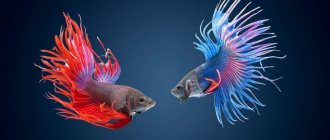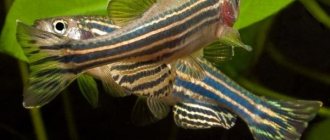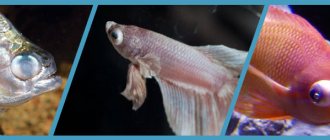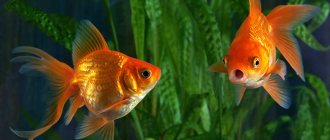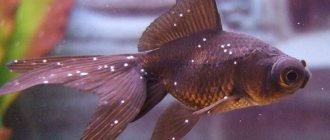Lepidorthosis is a common infectious disease that affects aquarium fish. Very often, aquarists have to deal with signs of disease, so it is important to know everything about the pathology in order to protect your pets. Learn more about what it is lepidorthosis, and will be discussed in this article.
Lepidorthosis in aquarium fish
Description of the disease
Lepidorthosis is a slow-onset disease, which, in the absence of timely and proper treatment, can lead to the death of infected fish. But for everything to go well, you need to learn to recognize the signs of pathology. As a rule, the causative agents of lepidorthosis live mainly in natural bodies of water. The disease spread along with fishing gear or special fish farming equipment.
What is lepidorthosis
Often the causative agent of the disease enters the aquarium along with aquatic plants , soil or decoration elements. Therefore, it is important to clean all objects before moving into the tank.
Sick aquarium fish
Incurable diseases
If at least one of the symptoms of the diseases listed below is detected, the fish should be immediately placed in a separate aquarium, and plants, walls and decorations must be disinfected in the main tank.
- Mycobacteriosis (tuberculosis for fish). Manifested by apathy, sudden weight loss, retracted stomach and rounded back. A sick individual becomes dull, hides at the bottom and hides from sunlight. The scales become unkempt, the tail hangs.
It is important to remember that mycobacteriosis is contagious, and therefore fish suspected of having it should be immediately isolated from others.
- Plistophorosis. This is an extremely rare genetic disease that is inherited.
With plistophorosis, the fish begins to swim vertically, turns pale when trying to assume its normal body position, and makes spasmodic movements. A sick individual refuses to eat and becomes apathetic. The stomach sinks.
Causes
Most often, the disease is caused by the bacteria Pseudomonas fluorescens, although other microorganisms, Aegomonas punctata, can also provoke the development of pathology. Since the disease progresses quite slowly, its symptoms are not easy to notice. The main reason for the appearance of lepidorthosis is the introduction of contaminated water, fishing equipment or sick fish the aquarium
Note! When relocating, aquarium fish must undergo quarantine in a holding tank. Otherwise, they may become carriers of the disease.
Characteristic symptoms
scales begin to rise in some areas of the fish's body . Over time, this symptom spreads to the entire body. The process of raising the scales is associated with the appearance of small air bubbles or, as they are also called, pustules. An increase in pustules under the scales can lead to their loss. Lepidorthosis is also accompanied by problems with gas exchange, which is especially dangerous for younger aquarium inhabitants, for whom skin respiration is very important.
Symptoms of the disease
Even if the fish’s scales begin to rise, this does not yet indicate the development of lepidorthosis. The fact is that similar symptoms can also occur with the development of other diseases, for example, mycobacteriosis . In order for the diagnosis to be made timely and, most importantly, correctly, it is necessary to take smears from infected individuals for further research.
Diagnostic features
To accurately determine the pathology, it is necessary to conduct microscopic examinations of smears taken from the affected tissues of a sick fish. In rare cases, when standard diagnostic methods do not help, microbiological testing may be performed. In this case, cultures are made from internal organs (spleen, liver or kidneys) or subcutaneous tissue.
How to identify lepidorthosis
On a note! It is important to diagnose lepidorthosis correctly, since the appearance of suspicious symptoms is not a reason to confirm the presence of the disease.
Reproduction problems
- Infertility. Sick females become dull and lose their color. Due to the inability to produce offspring, they become apathetic and irritable during the spawning period. The reasons why fish do not reproduce are congenital genetic diseases or severe violations of the norms for keeping guppies (exceeding the number of hours of daylight, increased or decreased acidity of the water, high hardness). There is no cure for infertility.
- Hermatophrodism. With this disease, in addition to female hormones, females also develop some male hormones. Sometimes self-fertilization occurs, resulting in infertile offspring. The causes of the disease and methods of its treatment are currently unknown.
Treatment of lepidorthosis
As soon as the disease is diagnosed, treatment should be started immediately. The fact is that Lepidorthosis can be treated exclusively in the early stages of development, when damage to the scales occurs only in certain areas of the body. baths are used as therapy . If the affected individuals are in a separate container, experts recommend using a special veterinary drug “Violet K”. Now about each of the treatment methods separately.
Treatment of lepidorthosis
"Bicillin-5"
A potent antibacterial agent of a combined type. Has a bactericidal effect on the affected organism. The drug is diluted in a small container with water and then added to the aquarium . Depending on the size and number of fish, the dosage may vary. The duration of the therapeutic course is 6 days. In this case, the medicinal solution must be applied daily. It is important that a freshly prepared solution is added each time.
"Bicillin-5"
"Sulfanilamide"
This drug is popularly known as white streptocide. For an aquarium with a capacity of 100 liters, 15 g of the drug is enough. The drug must be applied daily, after diluting it in a glass of water. White streptocide should be used for 4 weeks.
"Sulfanilamide"
"Biomycin"
An antibacterial drug that contains neomycin and amoxicillin. The drug has an additive effect. When treating lepidorthosis in aquarium fish, it is necessary to administer the drug at the rate of 1.4 g of medication per 100 liters of water. As in previous cases, the medicine must be applied daily, after diluting it in a glass of water.
Biomycin must be used for 30 days. This time should be enough to completely eliminate all symptoms of the disease.
Tetra General Tonic Tetra Contralck Sidex Tetra Bactozyme Tetra Vital Tetra NitrateMinus Tetra AquaSafe Hydrogen Peroxide
Therapeutic baths
As an addition to the previously mentioned drugs for lepidorthosis, medicinal baths . For this purpose, “Purple K” is used. To prepare a solution for the bath, you need to dilute 1 ml of the mother solution and “Violet K” in a liter of clean water. Then the affected fish must be placed in this solution for 4 days.
All aquarium fish with a late stage of lepidorthosis must be destroyed, and all aquarium equipment must be disinfected. Chloramine is used for disinfection.
Prevention measures
It is much easier to prevent the development of a disease than to deal with its symptoms. This applies not only to lepidorthosis, but also to other diseases of aquarium fish. But how to reduce the likelihood of pathology occurring? First of all, you need to follow a few simple recommendations.
- Freshly purchased fish must undergo special quarantine . It is strictly not recommended to immediately place it in an aquarium. The duration of quarantine is 3-4 weeks. The quarantine aquarium must be equipped with an aerator , a special filter and high-quality lighting.
- Overcrowding of the aquarium should be avoided . You cannot keep many pets in a relatively small tank. Otherwise, it may provoke the development of various diseases.
- It is important to regularly test your water using special test strips . It is necessary to control the PH level .
- To feed aquarium pets, you need to use only high-quality food and additives . Avoid all dubious manufacturers.
- All equipment in the aquarium must be in good working order , so it must be checked periodically to ensure it is working properly.
- When feeding the fish, you need to inspect them every day . This will allow us to identify possible signs of disease in the early stages of development.
It is also recommended to clean the aquarium and its walls. It is important that such operations are carried out regularly. Only by correctly implementing all of the above points can you significantly reduce the likelihood of developing serious diseases.
See also : The most unpretentious aquarium plants. In addition, you may be interested in the sacbranch catfish in the aquarium.
Hexamitosis, or hole disease
Fin rot in aquarium fish
Why do fish die in an aquarium?
White small worms on the glass of an aquarium
Pregnancy
After fertilization, the female carries the eggs in her body. The gestation period of a guppy lasts 1 month, sometimes a little less, rarely longer.
The duration of pregnancy is greatly influenced by the temperature of the water in the aquarium, so at high rates the birth of fry occurs faster than at low rates. Which does not have a negative impact on the formation of fry.
Sometimes, if the female has a light color, the fry can be seen through the abdomen. Clearly this guppy is about to give birth!
Signs of pregnancy become clearly visible in the later stages, when the fry have formed and are ready to be born. The fact that the female will give birth soon is indicated by:
- Significant increase in abdominal size;
- A dark spot around the anus appears and increases as labor approaches;
- The fish behaves secretly and seeks solitude.





